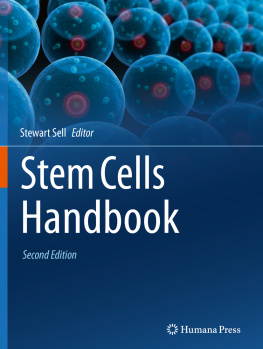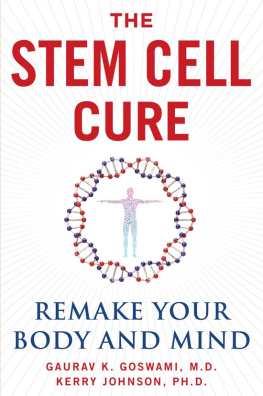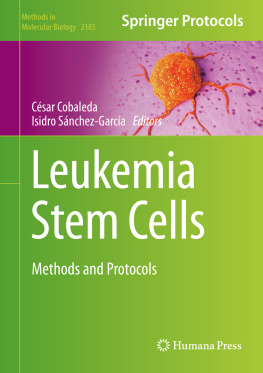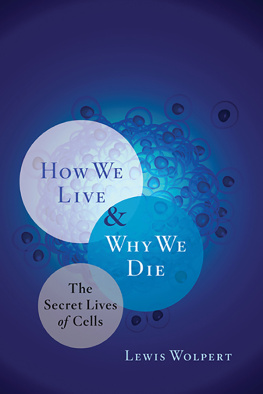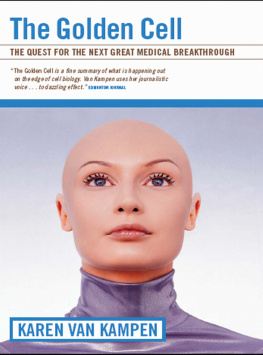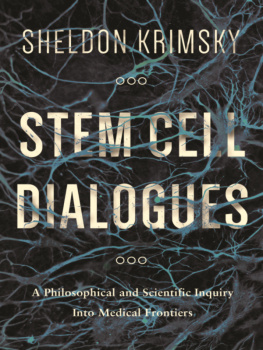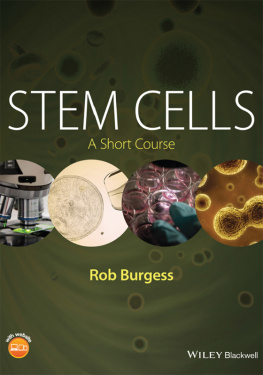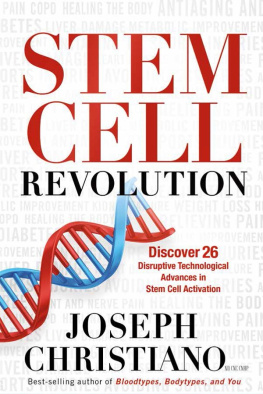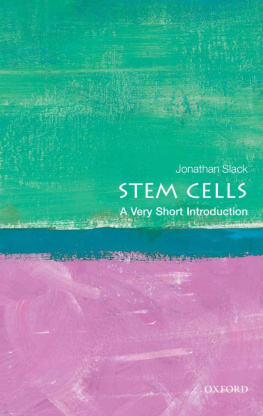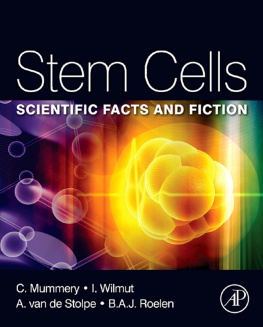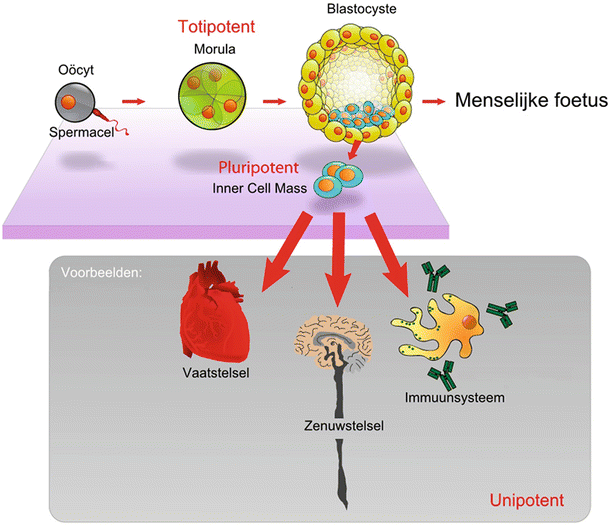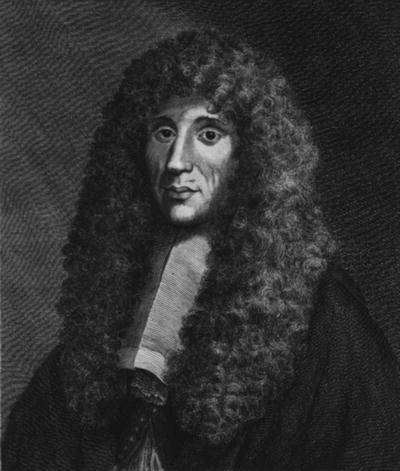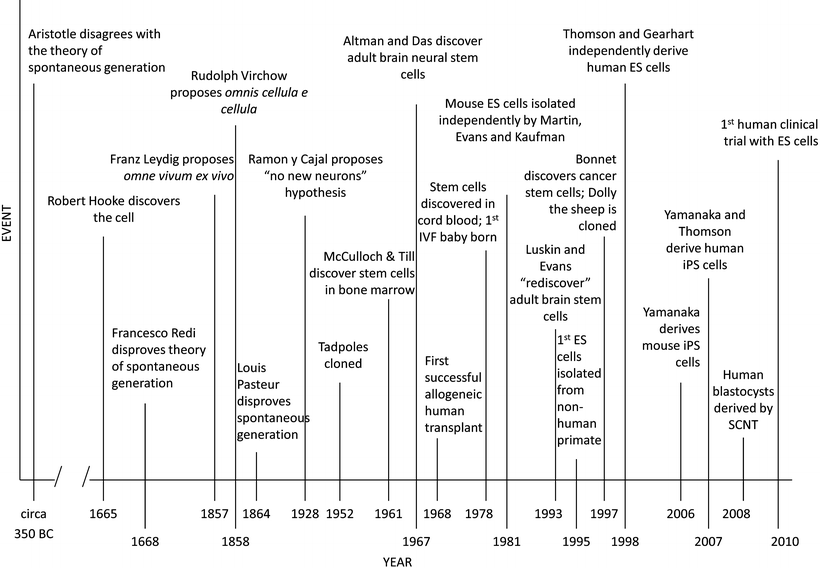Stewart Sell (ed.) Stem Cells Handbook 2nd ed. 2013 10.1007/978-1-4614-7696-2_1 Springer Science + Business Media New York 2013
Abstract
Chapter 1, Introduction to Stem Cells, provides a comprehensive introductory overview of stem cells and gives a unique historical perspective with respect to advances in stem cell-related research throughout the millennia. The chapter begins with a brief history of stem cell research and expands upon historical implications in each section, outlining and describing seminal findings which have led to significant advancements in stem cell-based therapeutics and even diagnostics efforts. The chapter emphasizes the developmental and biological origins of stem cells, noting key molecular, morphological, and biochemical events occurring during embryonic development which set the stage for potency acquisition, transition and, ultimately, stem cell commitment to mature, differentiated lineages. All major stem cell types are introduced to the reader in both historical and developmental context. In addition, cutting-edge technologies such as induced pluripotency and nuclear transfer are described. The chapter concludes with an overview of the emerging stem cell industry emphasizing stem cells as the major regenerative medicine technological platform.
Stem cells are present within most if not all multicellular organisms and are the ultimate drivers of growth and regeneration. They and are defined as biological cells capable of self-renewal and the capacity to differentiate into a variety of cell types. They are considered to be the most critical biological components necessary for proper growth and development during embryogenesis. Yet they have also been demonstrated to play indispensable roles in adult species, providing a much needed source of cellular replenishment for virtually every mature, differentiated cell type. All stem cells originate from what one might consider the ultimate stem cell, the fertilized egg. As a totipotent entity, the fertilized egg has the capacity to drive the formation of all intra- and extraembryonic tissues during growth and development. It is during the process of embryonic maturation that determination occurs wherein a variety of more specialized stem cell types are generated with differing properties that allow for the development of specific tissues and organs. For example, embryonic stem cells have the pluripotent capacity to drive the formation of all tissues of the embryo proper, but not extraembryonic tissues such as the placenta or amniotic membrane. As the embryo matures, determined multipotent stem cells are produced which provide a limited, albeit extremely powerful ability to produce more differentiated cell types. An example of multipotency is the stem cell population of the hematopoietic system, which drives blood formation from a common precursor stem cell both during embryonic development and for a lifetime after birth. While hematopoietic stem cells (HSCs) are capable of differentiation into a variety of blood cell types, they do not contribute to other organ systems; this restricted differentiation capacity defines them as adult in origin. Eventually in the mature adult, unipotent stem cells reside in a few select systems such as the heart and central nervous system (CNS) which have the capacity to differentiate into only one mature lineage (Fig. ).
Fig. 1
The origin and specialization of stem cells. See text for details (Courtesy Wikimedia Commons; reprinted with permission)
Gleaning a firm understanding of the genetic and biochemical hierarchies involved in embryonic and adult stem cell differentiation will no doubt lead to new cutting-edge cell-based and non-cell-based therapeutic strategies. In addition, whereas stem cells play crucial roles in embryonic development and adult tissue maintenance, their powerful mitotic properties may potentially mediate cancer development. The ability of stem cells to rapidly propagate can be deregulated and derailed resulting in oncogenic and ultimately tumorigenic properties. The theory of the existence of cancer stem cells is rapidly emerging and may open the door to new avenues for cancer treatment. Gaining a firm understanding of how cancer stem cells contribute to tumorigenic and metastatic phenotypes is key to developing new technologies and methods for cancer diagnosis and treatment. For example, targeting therapeutic entities to cancer stem cells present within a large population of tumor cells may be a powerful technique to rid the body of certain forms of cancer. Part V of this book takes an intimate look at this controversial field, outlining data gleaned on the existence and properties of cancer stem cells present in breast cancer, melanoma, and Wilms tumor.
A firm understanding of stem cell origins and biology is critical to the development of new modes of therapy. This chapter introduces the origins and basic concepts of stem cells, from embryonic to adult to cancer, and emphasizes key areas of stem cell research and focus that are described and highlighted by leaders in the field in following chapters. Particular attention is paid to the signaling cascades and genetic regulatory mechanisms underlying embryonic and adult stem cell development as well as the differentiation of stem cells into mature, cell type-specific lineages. Unless otherwise noted, the focus of this chapter and the majority of the book sections is on mammalian stem cells.
A Brief History of Stem Cell Research
The first records of man contemplating the origin of life and human development can be traced back to when the ancient Greeks believed that living entities could arise spontaneously ( Generatio spontanea ). Aristotle (384322 bc ) did not agree with the theory of spontaneous generation, but he did believe that order could arise from disorder. This led him to hypothesize that the embryo originates from the mothers menstrual blood. Aristotles hypotheses are well documented in Leslie Brainerd Areys comprehensive textbook Developmental Anatomy: A Textbook and Laboratory Manual of Embryology [).
Fig. 2
Portrait of Francesco Redi, the Italian physician first to disprove the theory of spontaneous generation
It was in the mid-1800s when Franz Leydig proposed that spontaneous generation in fact did not occur in any context and that all life comes from preexisting life ( omne vivum ex vivo ). Leydig was a German zoologist and comparative anatomist who specialized in the study of neural tissue at the University of Tubingen in Germany. In his seminal publication Lehrbuch der Histologie des Menschen und der Tiere he not only outlined crucial developments in the study of histology (including the groundbreaking research of Jan Evangelista Purkyne in 1837), he also emphasized his theory on the origin of life [. The discovery and characterization of particular types of embryonic and adult stem cells and their potential uses in regenerative medicine are described therein.

